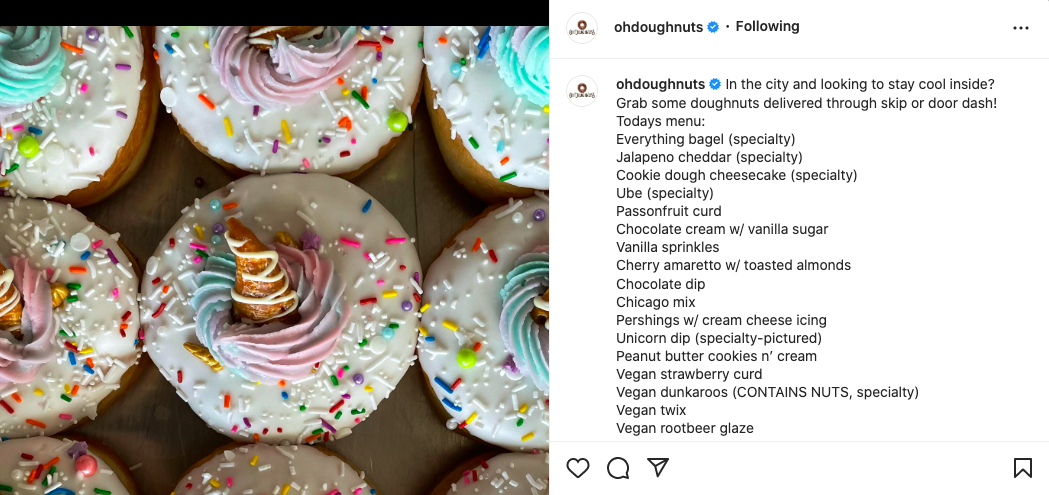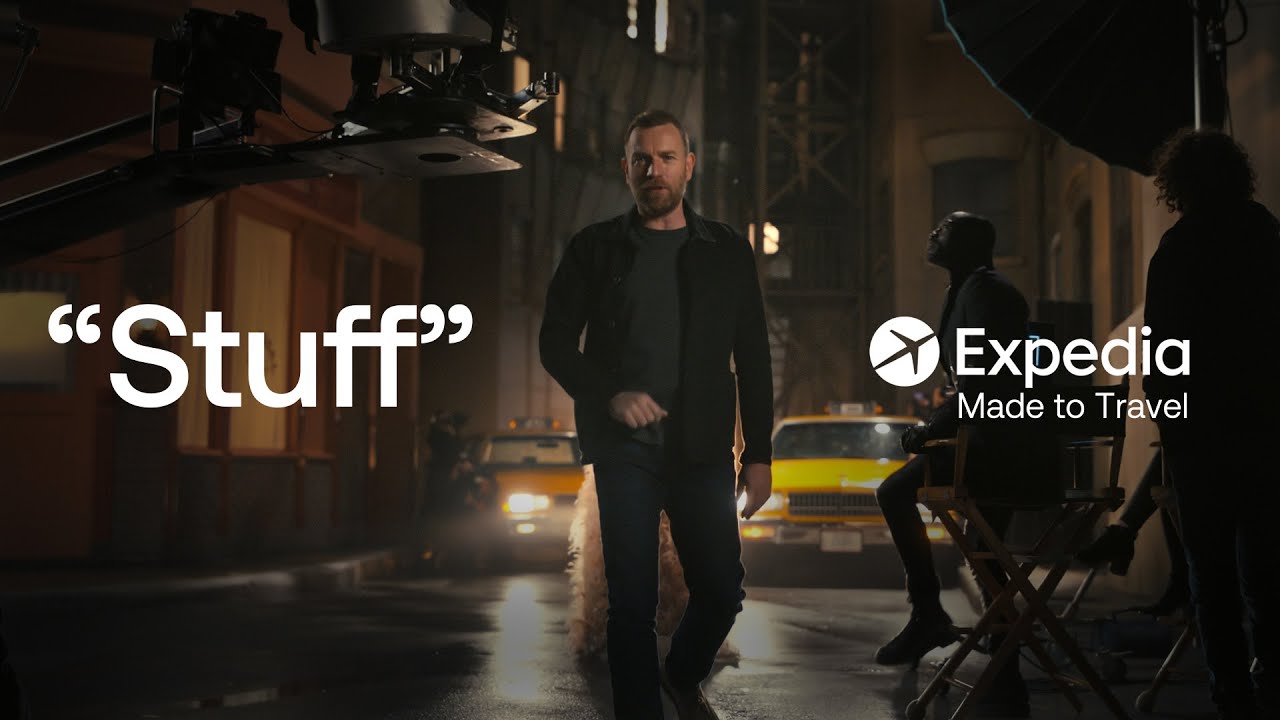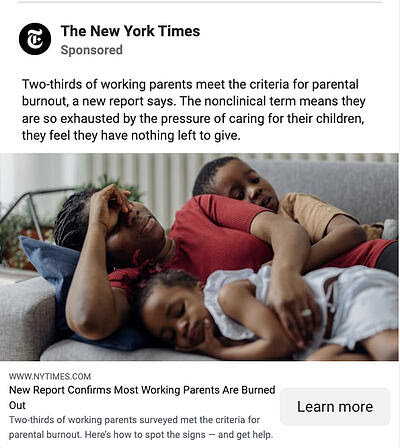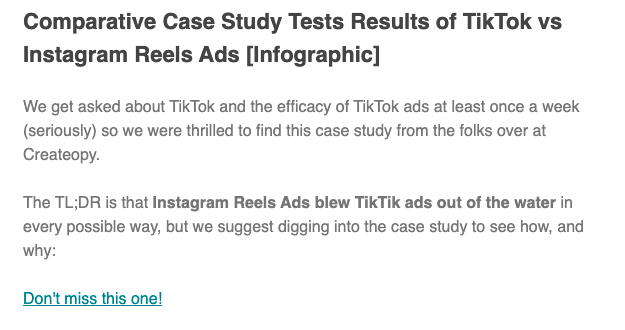The #1 Question Every Piece of Your Content Should Answer
This guest post was written by Rose Regier.
So you’re sitting down to create some content for your digital marketing channels. You’re doing this a month ahead of time because you read this and you get why posting on the fly is a) not strategic and b) not the best use of your time.
Your first thought might be, “What’s new in our business that we can talk about? What haven’t we talked about yet? Hmmmm, do we have any nice photos to share? Should we jump on a TikTok trend? Maybe show our support for an issue everyone is talking about?”
You draft some content and are about to put it into your queue - here’s where we’re going to stop you.
Before you’re done, you need to make sure every piece of content you just drafted answers this one question:
“What’s in it for my customer?”
Running each piece of your content through your own internal “What’s in it for them” filter might be the single most important way to make sure your digital marketing is strategic.
Every person (whether they’re aware of it or not) is walking around the world trying to find what’s in it for them—as they scroll, as they shop, as they eat, and as they binge a show. They’re looking for a payoff.
We’re Wired for Connection
It might seem selfish, but actually it’s just human nature. We’re driven to connect what’s out there to our personal experience.
Brené Brown is a researcher who’s spent the past two decades studying courage, vulnerability, shame, and empathy. Here’s what she found:
“Connection is why we're here. We are hardwired to connect with others, it's what gives purpose and meaning to our lives, and without it there is suffering.”
Understanding this fundamental drive will change the way you relate to your customer and also deepen your relationship with them.
This is also why getting to know your ideal customer is so important. You can’t relate to everyone, so you need to understand the specific people with whom you’re trying to connect, to know what they want from you.
Part of the client onboarding process at Starling Social is creating your ideal customer personas. The exercise itself is often very clarifying for our clients, and from there we can use these personas as a reference when we’re crafting your content, so we can act as an extension of your brand.
All this talk about connection and meaning might sound a little deep for a digital marketing strategy, but this doesn’t mean your content has to be serious. You don’t have to strike at the heart of your customers’ desires and pain points every time. It could be that sometimes your customer is looking for a little escape, for beauty, for some entertainment, or for a laugh.
In addition to considering what your customer wants from you, how you connect also depends on your brand. If you’re not sure what your brand is, start with our post on brand questions by Chelsée Curé.
Finding Your Content Sweet Spot
Your brand + what’s in it for your customer = your content sweet spot
The more you hit that content sweet spot, the more likely it is that your customers will want to engage with your stuff.
Some companies focus inward too much and only consider their offerings when creating content. They forget that your blog and your social media channels are a conversation.
It’s kind of like going on a first date and the person you’re meeting with talks nonstop. It only takes a few minutes of this before you’re eyeing the door, and getting out of an in person conversation is a lot harder than a simple unfollow.
Asking what’s in it for your customer will ensure you don’t get tunnel vision so they keep coming back for more.
Have we convinced you? Ok great, now let’s put it into practice.
What’s In It for You: Examples
Have you seen the acronym TL;DR in our weekly newsletter? It stands for “Too long; didn’t read” and we use it to give you a quick summary of something we read so you don’t have to.
What’s in it for you? You get all the juicy info without having to read a long (and possibly boring) article, but we always include a link in case you want to dive in.

What’s in it for you? Craving doughnuts? You can take a quick peek at Oh Doughnuts' IG to pick your flavour before you head to the shop. This post also lets you know that you can have doughnuts delivered to your house, which means you don’t have to get sweaty to get doughnuts.

This Expedia commercial with Ewen McGregor acknowledges—and pokes fun at— our obsession with accumulating stuff, and then ends with him walking onto a white sand beach. You hear the waves crashing and see a family with two kids running into the water.
What’s in it for you? Spending your money on experiences instead of stuff will make you happier, and Expedia will help you save more on those experiences.
Its especially inspirational because most of us have spent the better part of two years stuck at home with online shopping or home renovations filling the void left by lack of travel. We’re ready to have experiences again.

This Facebook Ad for an article by The New York Times is geared toward parents of young children. The copy and image are a great example of a company understanding its customers and where they are at right now.
What’s in it for you? Validation. Knowing you’re not alone and you’re not abnormal for feeling burnt out is a relief, plus the article offers a way out.
What Do Your Customers Want?
What do each of these examples have in common? Yes, they all make it clear what’s in it for you, but what’s in it for you in each case is a feeling rather than a product—ease, happiness, validation.
These examples hit on another fundamental truth when it comes to marketing: what your customers want isn’t just a product/service, they want the feeling that accompanies it.
Curious about how else we can help you be more strategic with your digital marketing? Get in touch! We’d be happy to answer your questions.


